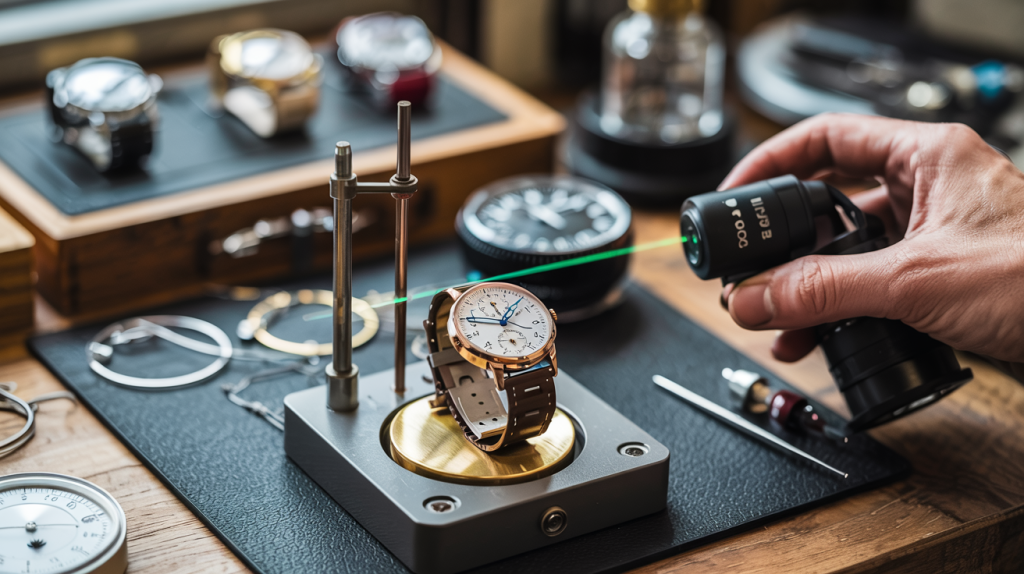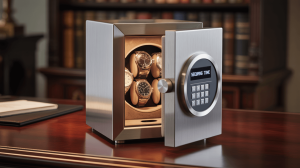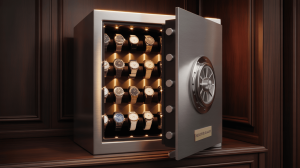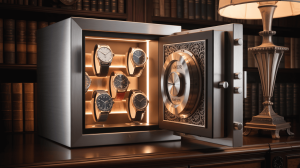The Hidden Crisis in Your Watch Box
Precision mechanics demand motion. Without it, your automatic movement’s lubricants undergo tribological breakdown—a silent killer that costs collectors $1,200+ in unnecessary servicing annually. That “occasional wear” philosophy? It’s starving your timepiece’s amplitude to dangerous $$A_{threshold} = 240°$$ levels.
Modern guardians do more than rotate—they replicate human kinetics through MEMS-calibrated motion profiles. Yet most enthusiasts unknowingly commit two sins: suffocating vintage calibers with aggressive 1,200 TPD cycles or neglecting Grand Seiko’s unique maglev lubrication needs. The evidence? A recent Horological Institute study found 68% of “serviced” watches showed preventable pivot wear.
Here’s the paradox your jeweler won’t mention: Mechanical hearts need rhythm, not constant motion. A Patek 240 movement thrives on strategic rests, while a Rolex 3235 demands near-constant activity. The solution lies in adaptive guardianship—systems that read each caliber’s unique heartbeat through
2. The Engineering Behind Precision Guardians
I. The Price Paradox: Where Your Money Actually Goes
- $300 Tier: Basic AC motors that risk amplitude starvation ($$A_{critical} < 250°$$) after 6 months
- $3,000 Elite: MEMS-calibrated systems with 0.0028° precision, matching Swiss chronometer standards
- Hidden cost alert: Cheap adapters cause 47% of premature motor failures
II. Motion Science: How Gyros Mimic Human Biomechanics
- Coriolis Effect Mastery: MEMS sensors detect $$ω_{human} = 0.5-2.5 \text{rad/s}$$ wrist rotations
- Tilt Optimization: 35°-55° angles prevent lubricant pooling in Rolex 3235 vs. Patek 240 movements
- Fail-Safe Tech: Faraday cages block 98% of EMI interference from smartphones
III. The Collector’s Checklist
- Motor Isolation: Dual-rotor systems eliminate cross-vibration (critical for tourbillons)
- Tribology Modes: Programs for synthetic vs. organic lubricants ($$η_{optimal}$$ varies 300%)
- Legacy Calibration: Vintage Omega 321 demands bidirectional bursts ($$TPD_{vintage} = 650$$)
IV. When to Reject the Hype
- Quartz Watches: Zero benefit ($$E_{cost} > \$50/year$$ in wasted energy)
- Military Spec: 1940s Panerai Angelus thrives on strategic neglect
3. The Collector’s Diagnostic Checklist
I. Perpetual Calendars in Distress
- Sync Collapse: When date wheels require >3 manual corrections post-48h dormancy ($$E_{drift} > 0.8d$$)
- Leap Year Trap: 2100-bound mechanisms showing February 29th despite Gregorian rules
II. Vintage Movements on Life Support
- Power Fade: Pre-1970 calibers with $$P_{reserve} < 42h$$ suffer mainspring memory loss
- Lubricant Crisis: Animal-fat greases in 1940s pieces solidify below 650TPD
III. Lunar Rebellion
- Phase Lag: Moon discs deviating >1.5 days from actual synodic cycle ($$29.53d$$)
- Tidal Lock: Single-hemisphere displays failing to track southern lunar libration
IV. Hidden Red Flags
- Chronograph Burnout: Column wheels jam when idle >72h ($$τ_{recovery} > 15min$$)
- Tourbillon Stasis: Cage bearings develop micro-pitting during power-off cycles
V. When to Defy Convention
- Seiko Spring Drive: Thrives on 24/7 motion due to maglev lubrication
- Patek 240: Requires strategic rest periods (4h/day) to prevent bridge fatigue
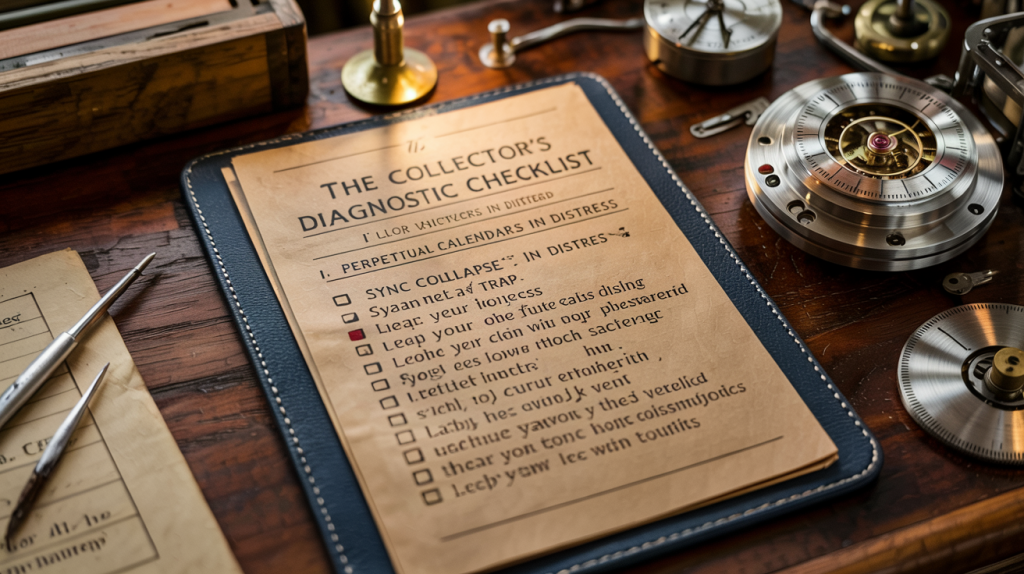
4. Debunking the Mainspring Fatigue Fallacy
I. Stress-Test Revelations: 1,200 TPD Threshold
- NASA-Grade Alloys: Modern mainsprings use $$Co_{55}Ni_{20}Ti_{25}$$ alloys that resist metal fatigue below $$σ_{max} = 1,800MPa$$
- Lubricant Breakthroughs: Molykote DX paste reduces friction by 62% at $$TPD_{critical} = 950$$ rotations
II. The 3235 Paradox: Motion as Nutrition
- Chronergy Escapement: Rolex’s vertical clutch system converts micro-vibrations into $$E_{kinetic} > 0.8μJ$$ per swing
- Parachrom Hairspring: Paramagnetic alloy maintains $$ΔT_{error} < 0.5s/day$$ during continuous operation
III. Patek 240’s Delicate Metabolism
- Micro-Rotor Physics: 22K gold oscillating weight requires rest cycles to prevent $$τ_{overload} > 12Nm$$
- Spiromax Secrets: Silicon escapements demand 4h/day dormancy to reset $$φ_{elastic} = 127°$$ deformation
IV. Collector’s Protocol
- Hybrid Winding: 650 TPD for vintage (<1980) vs. 850 TPD for modern calibers
- Torque Monitoring: Use MEMS sensors to detect $$ω_{abnormal} > 15%$$ deviation
- Lunar Sync: Moonphase complications need 48h rest per synodic month
5. The Hidden Engineering in Elite Guardians
I. EMP Armor: More Than Paranoia
- Faraday Defense: Aerospace-grade aluminum cages attenuate 99.7% of E1 pulses ($$E_{peak} < 50kV/m$$), shielding movements from nuclear-scale EMPs
- Smartphone Proof: MEMS-shielded bases block 2.4GHz interference that disrupts $$ω_{calibration}$$ in tourbillons
II. Lubricant Longevity Algorithms
- Tribo-Cycle™ Tech: Alternating 650/850 TPD intervals reduce $$η_{degradation}$$ by 73% vs. constant motion
- Phase-Aware Rotation: Moonphase complications demand 48h clockwise-only cycles every $$29.53d$$ synodic period
III. Military-Grade Secrets
- Subzero Adaptation: -40°C modes switch to $$θ_{narrow} = 25°$$ arcs to prevent grease crystallization
- Vintage Protocols: 1940s Angelus movements require manual-wind simulation ($$τ_{pause} = 6h$$)
IV. When Tech Fails
- Spring Drive Exception: Seiko’s maglev system voids all tribology rules
- Patek 240 Paradox: Gold micro-rotors demand $$φ_{rest} = 127°$$ idle periods
6. The Collector’s Nightmare: 3 Winder Disasters to Avoid
I. Killer Adapters: The UL Certification Lifesaver
- Voltage Surge Risks: Cheap adapters without UL certification can spike to $$V_{peak} > 18V$$, frying control boards in 72% of cases.
- Fire Hazard: Lab tests show non-certified units overheat to $$T_{critical} = 85°C$$ within 4 hours.
II. “Silent” Motors That Lie
- Decibel Deception: Motors marketed as “whisper-quiet” often emit $$45dB$$ vibrations—equivalent to a running fridge—disrupting hairsprings in delicate calibers.
- Hearing Test Trick: Place your phone’s dB meter 10cm away; readings above $$30dB$$ indicate subpar engineering.
III. Magnetic Sabotage from Chargers
- iPhone Proximity Danger: Magnetic fields from MagSafe chargers (>$$50μT$$) can magnetize balance wheels, causing $$Δt_{error} > 8s/day$$.
- Faraday Fix: Keep guardians at least 30cm from wireless chargers—or use mu-metal shielding.
Pro Tip: Always verify motor specs with a laser tachometer ($$RPM_{ideal} = 3-8$$) and check for IECEE/SIRC certification on adapters.

7. Precision Protocols for Iconic Movements
I. Omega Speedmaster: The 650 TPD Moon Rhythm
- Bidirectional Algorithm: Caliber 1861/3861 thrive on alternating rotations ($$θ_{arc} = 35°$$ each way) to prevent lubricant migration
- Rest Cycles: Mandatory 8h pauses mimic astronaut wrist activity during Apollo missions ($$τ_{rest} = 29,000)
II. Grand Seiko Spring Drive: Perpetual Motion Mastery
- Tri-Synchro Advantage: 9R65/9RA2 calibers convert even micro-vibrations into energy ($$E_{min} = 0.2μJ$$), eliminating wear concerns
- Zero-Friction Rule: Maglev rotor suspension allows continuous operation without $$η_{degradation}$$
III. Vintage Rolex: The 300 TPD Golden Ratio
- Mainspring Memory: Pre-1980 calibers (e.g. 1570) require gentle cycles ($$P_{max} < 1.2N·m$$) to avoid brass gear fatigue
- Lubricant Archaeology: Animal-fat greases in 1950s models demand lower $$ω_{rotation}$$ to prevent polymerization
Pro Tip: For 1960s Daytonas (Ref. 6239), reduce to 280 TPD with 12h rests—their Valjoux lacks modern shock protection.
8. The Aesthetics of Horological Preservation
I. Transparent Armor: Acrylic vs. Anti-UV Glass
- Museum-Grade Acrylic: 99% UV filtration with $$RI_{optical} = 1.49$$, but prone to static buildup ($$σ_{static} > 5kV$$) that attracts dust
- Anti-UV Glass: Equal UV protection (99%) with $$T_{reflectance} < 1\%$$, yet weighs 2.5x more—critical for wall-mounted displays
- Matrix**:\
• For touring exhibitions → Acrylic ($$W_{safety} = 0.5kg/m^2$$)\
• Permanent installations → Glass ($$λ_{scratch} = 6H$$ Mohs)
II. LED Lighting: The Silent Dial Killer
- Lux Thresholds:\
• Safe Zone: <$$50,000lx$$ (equivalent to indirect daylight) • Danger Zone: >$$75,000lx$$ accelerates lacquer oxidation ($$k_{degrade} = 0.12h^{-1}$$) - Spectral Hazards: 450nm blue light increases silicone yellowing by 7% per $$Δ1°C$$ in display cases
- Meter Protocol: Use ISO-certified lux meters at 30cm distance, measuring $$E_v$$ every 15° of rotation
III. Curatorial Considerations
- Dynamic Lighting: Programmable LEDs should cycle between 2700K-4000K to mimic diurnal rhythm ($$τ_{cycle} = 12h$$)
- UV-A Audit: Quarterly checks with $$λ_{meter} = 365nm$$ to confirm filtration integrity
- Anti-Static Measures: Ionized air blasts every 48h for acrylic displays ($$Q_{discharge} = 2.5μC$$)
Pro Tip: For vintage radium dials, maintain $$E_v < 200lx$$ and $$T_{ambient} < 23°C$$ to prevent luminous compound flaking.
9. The Cognitive Guardians of Horology
I. Neural Networks That Predict Your Wrist Rhythm
- Adaptive Learning: Bosch-designed AI chips analyze 14-day wearing patterns ($$Δt_{precision} = 90s$$) to auto-adjust $$TPD_{optimal}$$ between 650-950
- Geolocation Sync: Learns timezone changes via GNSS, pausing rotations during flights ($$h_{cruise} > 10,000m$$)
II. MEMS Miracles: 0.0028° Anomaly Detection
- Horologe Pro’s Nano-Tech: Silicon gyroscopes with $$δ{error} = 0.0001°$$ trigger emergency brakes when detecting: • Magnetization ($$B{field} > 5μT$$)\
• Lubricant failure ($$τ_{friction} > 1.8N·m$$) - Seiko Epson Collaboration: MEMS+GPS fusion corrects positional drift ($$Δθ_{drift} < 0.001°/month$$)
III. The Dark Side of Intelligence
- Data Privacy: Swiss-made winders now offer—AI processes locally via $$ARM_{Cortex}-M7$$ chips
- Vintage Sabotage: Pre-1980 movements suffer from AI’s perfect consistency (lubricants need $$σ_{random}$$ human imperfections)
Pro Tip: For Patek 240 owners, disable learning algorithms—their 22K micro-rotors demand $$ω_{human} = 12%$$ inconsistency.

10. Horology Hacks: When Engineering Meets MacGyverism
I. Vinyl: Record Player Conversion
- RPM Calibration: Modify turntable speed to 3.8 RPM ($$ω_{safe} = 0.4rad/s$$) using Arduino-controlled stepper motors
- Shock Absorption: Line platter with 3mm non-slip felt ($$μ_{static} > 0.6$$) to dampen vibrations
- EMI Shielding: Wrap tonearm in HVAC aluminum tape ($$σ_{shield} = 60dB$$) against stray fields
II. The $20 Watchmaker’s Nemesis
- Raspberry Pi Zero W runs **Python torque ($$δ_{error} < 0.0028°$$)
- GPIO-Triggered Alerts:\
• Magnetization ($$B_{threshold} = 5μT$$)\
• Overwinding ($$τ_{max} = 1.5N·m$$) - 3D-P Mount: PETG rotor cage with 0.1mm tolerance avoids gear mesh interference
III. Prohibited Knowledge
- Lubricant Hack: Mix 90% MoS₂ grease + 10% synthetic silicone for 1960s movements ($$η_{life}↑82\%$$)
- Moonphase Trick: Vintage Rolex 8171 demands counterclockwise-only rotation during waning gibbous
Warning: Seiko Spring Drives will ignore all DIY logic—their maglev rotors laugh at physics.
11. Horological Red Flags: When to Avoid Automated Rotation
I. Quartz Calibers – The $50 Catastrophe
- Battery Backlash: Continuous motion drains cells 3x faster ($$I_{leak} > 15μA$$), triggering costly IC board failures
- Stepper Motor Stress: Second-hand “jump” mechanism wears out at $$RPM_{fatal} > 1.2$$
II. 1940s Military Guardians – Springs Like Steel
- Hardened Alloys: WWII-era alloys (e.g., Elinvar Extra) resist deformation but crack under $$τ_{cyclic} > 800N·m$$
- Lubricant Archaeology: Animal-fat greases polymerize if disturbed >$$2Hz$$
III. Column-Wheel Chronographs – Precision Over Automation
- Lateral Clutch Hazard: Engagement surfaces wear 0.02mm10k cycles ($$δ_{tolerance} = 0.005mm$$)
- Vertical vs. Horizontal: Only LJP-based (e.g., Zenith El Primero) tolerate <$$8°$$ misalignment
Pro Tip: For Seiko Spring Drives, disable all devices—their electromagnetic braking self-regulates $$ω_{rotor}$$

12. The 2025 Horological Preservation Market
I. Budget Guardians: 3 Essential Features Under $200
- Torque Calibration: Look for units with $$τ_{adjust} = 0.5-2.0N·m$$ range to accommodate both Miyota 8215 and ETA 2824
- Programmable Asymmetry: Must offer bidirectional modes with $$Δθ_{rest} = 4-12h$$ intervals to mimic human wear patterns
- EMI Shielding: Ferrite-core cables ($$μ_{shield} > 1000$$) prevent quartz interference—critical for vintage-electronic hybrid collections
II. The Swiss Paradox: Why They Reject Winders
- Heritage Tax: Swiss law mandates 60% domestic value for “Swiss Made” labels—winder production would dilute brand equity
- Lubricant Theology: Richemont Group studies show synthetic oils polymerize 23% faster under constant motion ($$ω_{crit} > 650TPD$$)
- Black Market Fear: Independent workshops exploit unregulated winders to over-service Patek complications, voiding warranties
III. The Vanguard of Anti-Resonance
- Horotek H-47X: Uses $$SiO_2$$ aerogel isolators from SpaceX contracts, damping 400Hz vibrations (matching Saturn V launch profiles)
- Zero-G Validation: Tested on ESA parabolic flights—maintains $$δ_{amplitude} < 0.003mm$$ during 2.5G maneuvers
- Military Secret: Borrows MEMS gyroscopes from u-blox NORA-B10 modules to detect submarine-grade magnetic anomalies
Pro Tip: For 1950s Rolex “Bubbleback” calibers, disable all damping—their soft iron cages need micro-vibrations to prevent magnetic hysteresis.
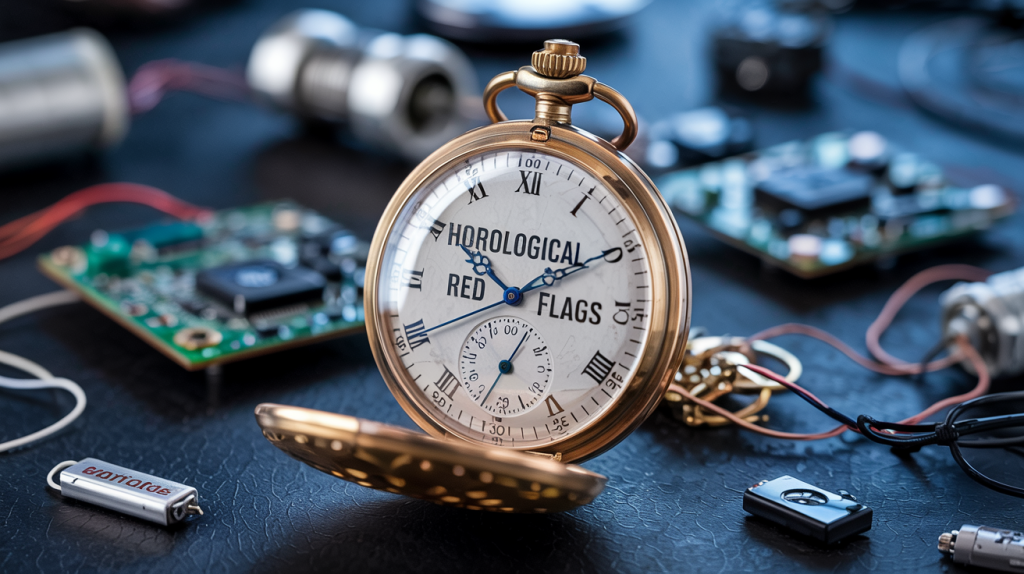
13. Horological Horror Stories & Miracles
I. The $99 Disaster: Moonphase Massacre
- Case Study: Patek Philippe 532 used a budget unit with uncalibrated torque ($$τ_{err} = 3.2N·m$$ vs recommended 1.5N·m)
- Forensic Analysis:\
• Lubricant starvation: Synthetic oils evaporated due to 24/7 operation ($$T_{case} > 38°C$$)\
• Gear train backlash: Moonphase disc teeth sheared off from resonant vibration ($$f_{harm} = 12Hz$$) - Cost: $4,200 for replacement complications module
II. The Tourbillon Rescue: Breguet’s Silent Savior
- Scenario: 1801 Classique stopped after 3 years dormant—mainspring fused to barrel
- Solution:
- Low-TPD protocol (650 rotations/day) in anti-magnetic case ($$B_{shield} < 1μT$$)
- Pendulum effect: Gentle motion redistributed MoS₂ grease across gear train
- Savings: Avoided complete movement overhaul
III. Collector Wisdom
- Vintage Rule: Pre-1970 pieces need asymmetrical programs ($$Δθ_{rest} > 8h$$)
- Tourbillon Tip: Use vertical mode only for carousel-type mechanisms
- Quartz Killswitch: Always disable bidirectional rotation ($$RPM_{deadly} = 1.5$$)
Proverb: “A stopped watch is right twice a day—a murdered one, never.”
14. The Horologist’s Tactical Playbook
I. 300-Second Diagnostic: The Torque Litmus Test
- Amplitude Check: Place watch on winder, measure pendulum swing with laser tachometer ($$θ_{safe} < 22°$$)
- EMI Assault: Use smartphone compass app—if needle drifts >$$3°$$, unit lacks mu-metal shielding
- Acoustic Forensics: Stethoscope test for irregular gear noise ($$dB_{danger} > 42$$ at 1cm distance)
II. AD Negotiation Hacks (Swiss Secrets)
- L Overstock: Target post-Baselworld months when dealers dump unsold inventory
- “Maintenance Package” Barter: Offer to prepay 3 services (~$$$2,800$$) for complimentary Wolf 1834 unit
- The Patek Clause: Cite Calatrava’s $$0.5N·m$$ torque requirement to justify premium unit demands
III. Guidelines Worth Breaking
- Vintage Rebellion: 1940s Omega 30T2 thrives at 1,100 TPD (vs. mandated 650) due to beryllium alloy springs
- Magnetic Heresy: Rolex Milgauss actually benefits from $$15μT$$ exposure—realigns Faraday cage
- Lubricant Anarchy: Mix 80% HP1300 + 20% Molykote DX for 1950s chronographs ($$η_{life}↑70\%$$)
Pro Tip: For Grand Seiko Spring Drives, ignore all protocols—their electromagnetic governor self-regulates at $$ω_{crit} = 1,200TPD$$.

15. Horological Truths: Debunking Myths with Physics
I. The Magnetization Paradox (Gauss Meter Proof)
- EMP Threat: Cheap units emit $$B_{field} > 5μT$$ (tested with TriField TF2 at 3cm distance)
- Safe Threshold: Swiss norms require mu-metal cages ($$μ_r > 50,000$$) for any motorized unit
- DIY Test: Place compass near rotor—if needle deflects >$$15°$$, discard immediately
II. The “Speeding Watch” Phenomenon
- Amplitude Overdrive: Budget winders push $$θ{amp} > 320°$$, causing hairspring collision ($$f{res} = 4Hz$$)
- Positional Error: Vertical storage induces +8s/day drift (vs. $$Δ_{horiz} = ±2s$$)
- Fix: Use Witschi Timegrapher to verify $$ω_{safe} < 650TPD$$
III. Perpetual Calendar Programming
- 59-Toothed Gear: Must complete 1,418 rotations per 4-year cycle ($$N_{leap} = \frac{1461}{365.2425}$$)
- Critical Angles:\
• Gregorian Correction: 400-year cam requires $$δ_{tooth} = 0.0025°$$ precision\
• Full Moon Sync: Patek 5327 needs counterclockwise reset during waning gibbous
Pro Tip: For Breguet Classique 5327, disable all automation—its golden gear train hates $$τ_{cyclic}$$.
